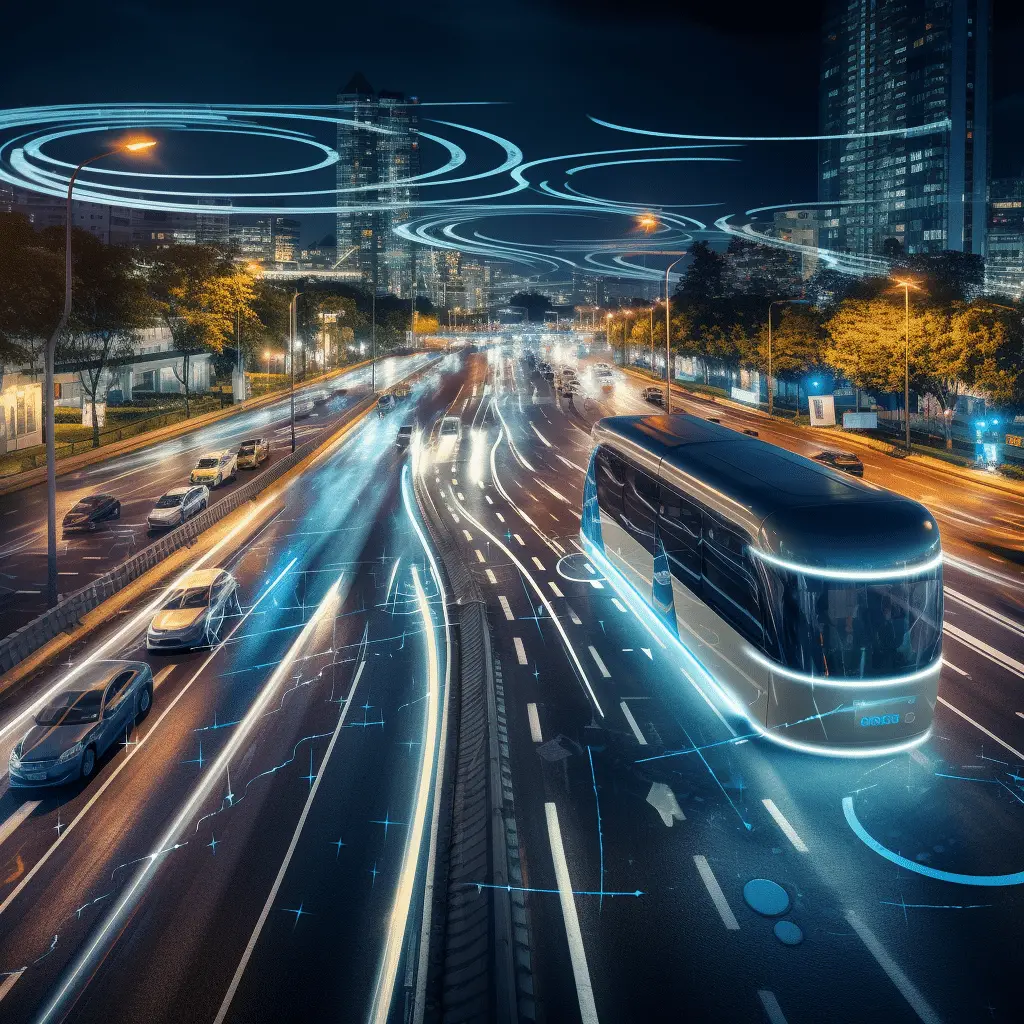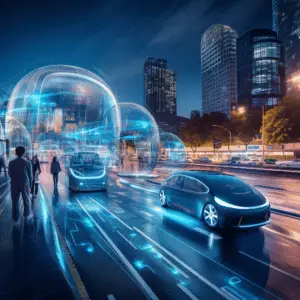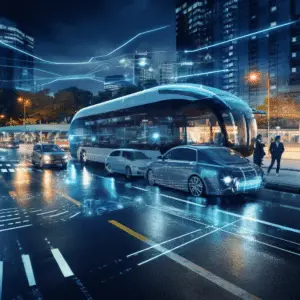
What Impact is AI Having on Autonomous Vehicles?
Autonomous Vehicle AI, Rapid breakthroughs in AI technology have transformed several industries, including autonomous automobiles. The automobile industry is being transformed by AI, enabling vehicles to travel autonomously. The emergence of AI and driverless vehicles promises to improve road safety, efficiency, and accessibility.
Enhanced Safety
Autonomous vehicles are equipped with advanced sensors, cameras, and machine learning algorithms, enabling them to detect and respond to their surroundings with incredible precision. By utilizing powerful AI algorithms, these vehicles can identify and analyze objects, pedestrians, and other vehicles, making quick decisions to avoid accidents and mitigate risks. The real-time data gathered by AI systems enables autonomous vehicles to adapt to changing road conditions, predict potential hazards, and drive defensively, ultimately making our roads safer.
Improved Efficiency

Autonomous vehicles powered by AI can improve transportation systems by reducing traffic congestion, fuel consumption, and maintenance costs. AI systems enable vehicles to optimize travel time by evaluating traffic patterns and making smart judgments to avoid congestion. AI-enabled autonomous cars allow for intelligent V2V and V2I communication, resulting in a more efficient and synchronized transportation ecology.
Accessibility for All
AI integration in autonomous vehicles could transform transportation accessibility. Self-driving automobiles empower individuals who cannot drive, such as the elderly or disabled. Autonomous vehicles can improve the quality of life for persons who struggle with mobility by providing reliable and safe transportation options. Autonomous vehicles powered by AI can offer affordable transportation services, lowering automobile ownership and enabling new mobility-as-a-service models.
In conclusion, AI is undoubtedly changing the autonomous car scene. AI-powered autonomous vehicles with greater safety, efficiency, and accessibility will play a crucial role in our future. To maximize the potential of AI in making roads safer, greener, and more inclusive, responsible development, legal frameworks, and ongoing research are essential as technology advances rapidly.
In what ways is AI transforming the passenger experience and comfort within autonomous vehicles?
AI is transforming the passenger experience and comfort within autonomous vehicles in several ways:
1. Enhanced entertainment: AI systems can provide personalized entertainment options to passengers based on their preferences, such as music, movies, or games. It can also recommend content based on previous choices, ultimately improving the overall entertainment experience.
2. Intelligent personal assistant: AI-powered virtual assistants can help passengers with various tasks, such as adjusting the temperature, finding nearby restaurants, or even answering questions about the journey. These assistants can understand natural language and continuously learn to better cater to passenger needs.
3. Comfort optimization: AI algorithms can analyze various data points, such as passenger biometrics, seat position, and ambient conditions, to optimize comfort. It can adjust the seats, climate control, and ambient lighting to provide a personalized and comfortable experience for each passenger.
4. Routefinding and navigation: AI can analyze real-time traffic data, weather conditions, and passenger preferences to determine the most efficient and comfortable route for the journey. It can also adapt the route in case of any unexpected changes.
5. Predictive maintenance: AI enables predictive maintenance of autonomous vehicles by continuously monitoring various vehicle components and detecting any potential issues. This helps in identifying and addressing problems before they cause any inconvenience to the passengers.
6. Safety and security: AI systems can enhance passenger safety and security within autonomous vehicles. The system can detect and address traffic dangers, monitor passenger well-being, and provide emergency aid in case of accidents or medical problems.
AI technology significantly improves passenger experience in autonomous vehicles by personalizing services, maximizing comfort, enhancing safety, and simplifying journeys.
How is artificial intelligence revolutionizing the capabilities and safety features of autonomous vehicles?
Artificial intelligence (AI) is playing a crucial role in revolutionizing the capabilities and safety features of autonomous vehicles. Here are some ways AI is contributing to the advancements in this field:
1. Sensing and Perception:
AI enables autonomous vehicles to understand and interpret their surroundings using various sensors such as cameras, lidar, radar, and ultrasonic sensors. AI algorithms process the data from these sensors to identify objects, pedestrians, road conditions, and traffic signs, thus enhancing the perception capabilities.
2. Object Detection and Tracking:
AI algorithms employ computer vision techniques to detect and track objects in real-time. This allows autonomous vehicles to accurately identify and anticipate the movements of other vehicles, pedestrians, and cyclists, enabling them to make informed decisions for safe navigation.
3. Path Planning and Decision-Making:
AI enables autonomous vehicles to plan their routes, select optimal paths, and make decisions based on incoming data. Reinforcement learning and deep learning techniques are used to model complex driving scenarios, predict the behavior of other road users, and determine appropriate actions to ensure safety.
4. Predictive Maintenance:
AI allows autonomous vehicles to monitor their own health and predict potential failures or maintenance needs. Machine learning algorithms analyze data from various vehicle sensors and diagnostic systems to detect anomalies and identify patterns that can indicate impending issues, thereby reducing the risk of unexpected breakdowns or accidents.
5. Enhanced Safety Features:
AI enables advanced safety features like predictive collision avoidance, emergency braking, and adaptive cruise control. These features use AI algorithms to constantly analyze and assess the environment, alert drivers, and take corrective actions whenever required, making autonomous vehicles safer for both occupants and other road users.
6. Continuous Learning and Updates:
AI enables autonomous vehicles to learn and adapt from real-world driving experiences. AI algorithms can improve vehicle behavior, performance, and safety by analyzing massive volumes of data and identifying trends. This allows for regular software updates to improve the autonomous driving system over time.
By improving perception, decision-making, and predictive maintenance, artificial intelligence is modernizing autonomous vehicles and making them safer on the road.
What challenges and considerations arise from the integration of AI into autonomous vehicles, and how are they being addressed

There are several challenges and considerations that arise from the integration of AI into autonomous vehicles. Some of these include:
1. Safety: Safety is the primary concern when it comes to autonomous vehicles. Ensuring that AI systems can make accurate and reliable decisions in real-time situations is crucial. This includes handling unforeseen circumstances, such as extreme weather conditions or unpredictable human behavior.
2. Ethical decision-making: Autonomous vehicles may encounter situations where they have to make ethical decisions, such as choosing between two potentially harmful outcomes. Determining how AI systems should handle these situations raises complex ethical considerations.
3. Legal and regulatory framework: The integration of AI into autonomous vehicles raises legal and regulatory challenges. Policies and rules need to be established to define liability in case of accidents, data privacy and security, and ensure compliance with existing traffic laws.
4. Data quality and availability: AI systems require vast amounts of high-quality data to effectively learn and make decisions. Obtaining, processing, and maintaining this data can be a significant challenge, especially considering the diverse range of driving environments and scenarios.
5. User acceptance and trust: Gaining user acceptance and trust in autonomous vehicles with AI technology is an important consideration. Ensuring that users feel safe and comfortable relying on AI-driven systems for their transportation needs is crucial for widespread adoption.
These challenges are being addressed through various means, including:
1. Robust testing and validation: Extensive testing and validation procedures are being carried out to ensure the safety and reliability of autonomous vehicles. This includes simulated and real-world testing in various driving conditions to identify and fix potential issues.
2. Development of ethical guidelines: Industry organizations and researchers are working on developing guidelines and frameworks for ethical decision-making in autonomous vehicles. These guidelines aim to define principles for AI systems to follow when faced with difficult choices on the road.
3. Collaboration with regulatory bodies: Autonomous vehicle manufacturers and AI developers are collaborating with regulatory bodies to establish legal frameworks and standards for autonomous vehicles. This collaboration helps address liability concerns, data privacy, and security issues.
4. Advances in data collection and processing: Improved technologies for data collection, such as sensors and cameras, along with advancements in data processing and machine learning algorithms, are helping enhance the quality and availability of data for AI training.
5. Public education and awareness: Efforts are being made to educate the public about the capabilities and limitations of autonomous vehicles. Increasing awareness and understanding of the technology can help build trust and acceptance among users.
Overall, addressing these challenges requires a multi-faceted approach involving technological advancements, collaboration, regulatory frameworks, and public engagement to ensure the safe and successful integration of AI into autonomous vehicles.








